System Thinking Report on Sumo Salad's Inventory Management Issues
VerifiedAdded on 2022/09/08
|9
|1771
|19
Report
AI Summary
This report analyzes Sumo Salad's inventory management problems using a system thinking approach, as requested in the MGT603 assignment brief. It begins with an introduction to Soft Systems Methodology (SSM) and its application to business problem-solving, particularly focusing on inventory management within Sumo Salad. The report includes a rich picture illustrating the current state of the business and a proposed future state with an improved inventory system. A detailed discussion of the CATWOE analysis is provided, examining Customers, Actors, Transformation, Worldview, Owner, and Environmental constraints. The report concludes with recommendations for implementing an inventory management system and potential unintended consequences. Finally, the report provides references to support its analysis.
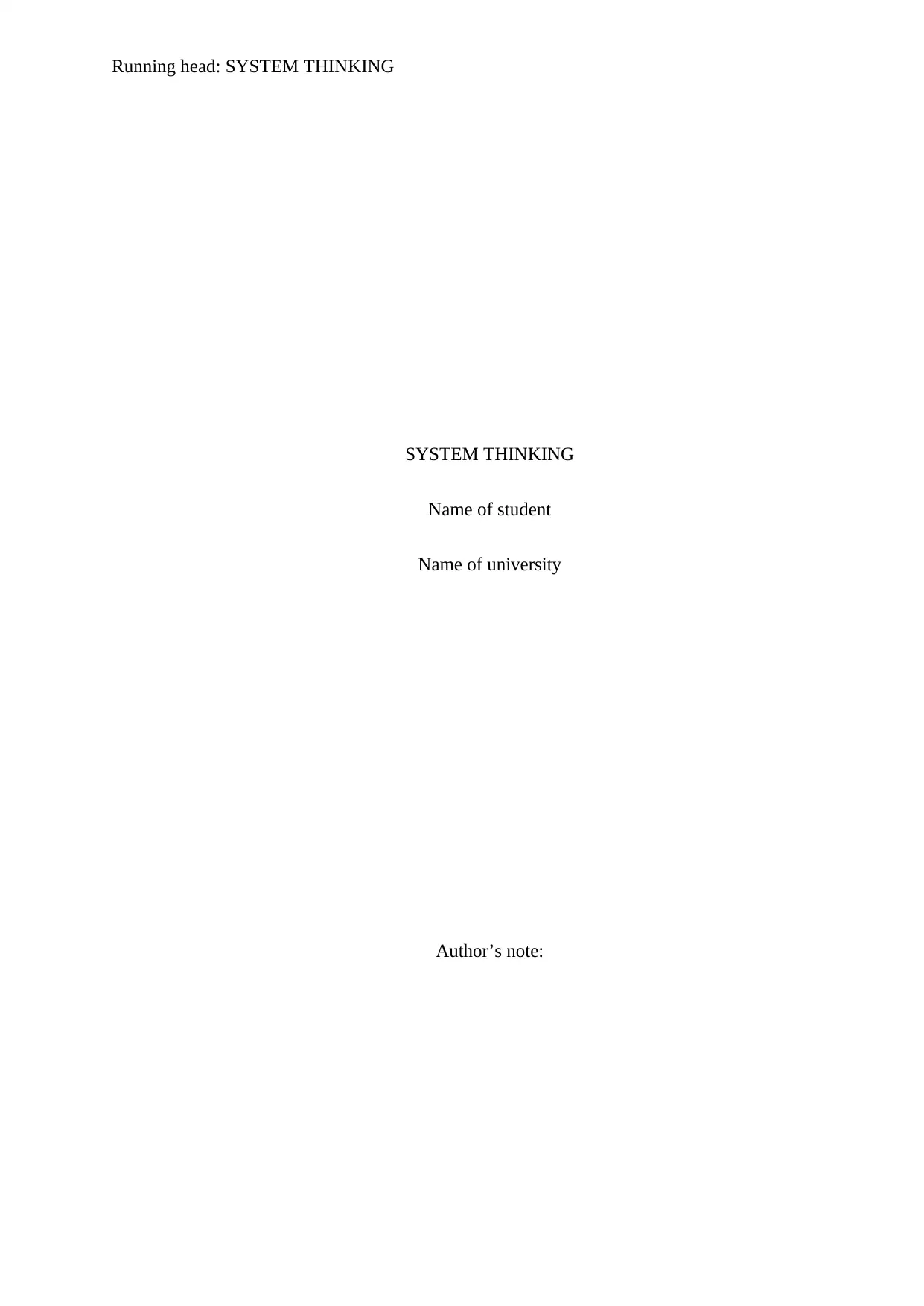
Running head: SYSTEM THINKING
SYSTEM THINKING
Name of student
Name of university
Author’s note:
SYSTEM THINKING
Name of student
Name of university
Author’s note:
Paraphrase This Document
Need a fresh take? Get an instant paraphrase of this document with our AI Paraphraser
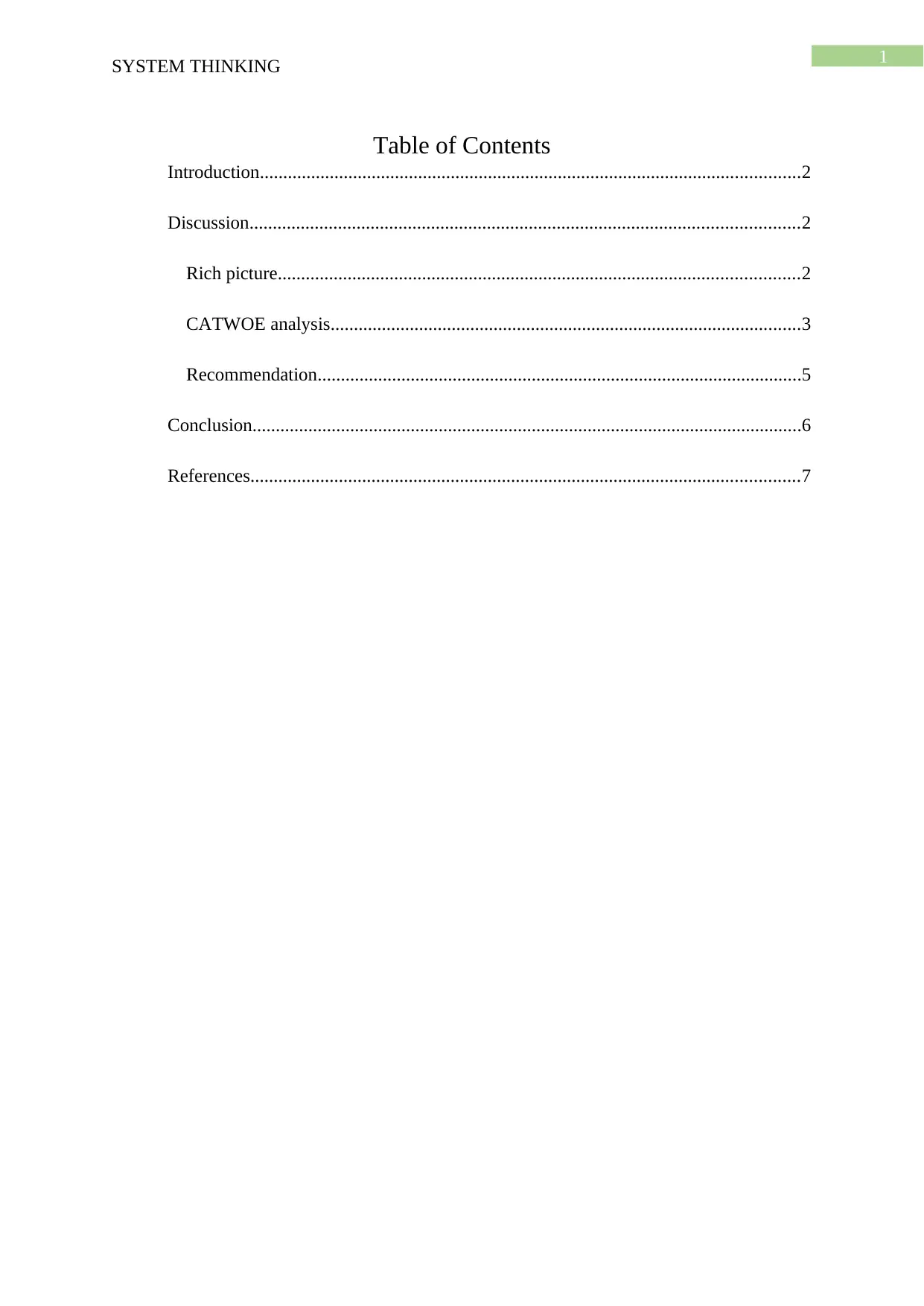
1
SYSTEM THINKING
Table of Contents
Introduction....................................................................................................................2
Discussion......................................................................................................................2
Rich picture................................................................................................................2
CATWOE analysis.....................................................................................................3
Recommendation........................................................................................................5
Conclusion......................................................................................................................6
References......................................................................................................................7
SYSTEM THINKING
Table of Contents
Introduction....................................................................................................................2
Discussion......................................................................................................................2
Rich picture................................................................................................................2
CATWOE analysis.....................................................................................................3
Recommendation........................................................................................................5
Conclusion......................................................................................................................6
References......................................................................................................................7
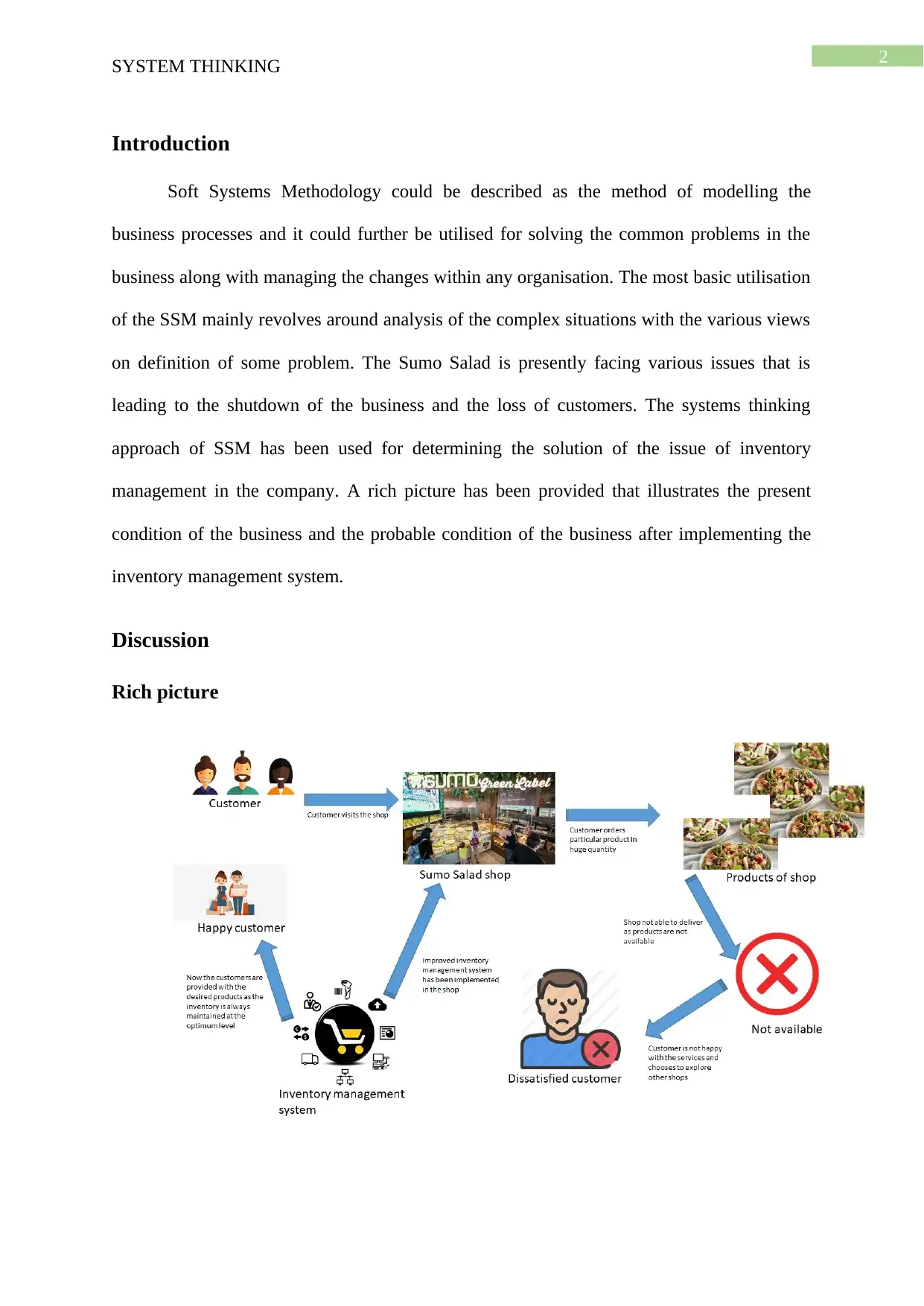
2
SYSTEM THINKING
Introduction
Soft Systems Methodology could be described as the method of modelling the
business processes and it could further be utilised for solving the common problems in the
business along with managing the changes within any organisation. The most basic utilisation
of the SSM mainly revolves around analysis of the complex situations with the various views
on definition of some problem. The Sumo Salad is presently facing various issues that is
leading to the shutdown of the business and the loss of customers. The systems thinking
approach of SSM has been used for determining the solution of the issue of inventory
management in the company. A rich picture has been provided that illustrates the present
condition of the business and the probable condition of the business after implementing the
inventory management system.
Discussion
Rich picture
SYSTEM THINKING
Introduction
Soft Systems Methodology could be described as the method of modelling the
business processes and it could further be utilised for solving the common problems in the
business along with managing the changes within any organisation. The most basic utilisation
of the SSM mainly revolves around analysis of the complex situations with the various views
on definition of some problem. The Sumo Salad is presently facing various issues that is
leading to the shutdown of the business and the loss of customers. The systems thinking
approach of SSM has been used for determining the solution of the issue of inventory
management in the company. A rich picture has been provided that illustrates the present
condition of the business and the probable condition of the business after implementing the
inventory management system.
Discussion
Rich picture
⊘ This is a preview!⊘
Do you want full access?
Subscribe today to unlock all pages.

Trusted by 1+ million students worldwide
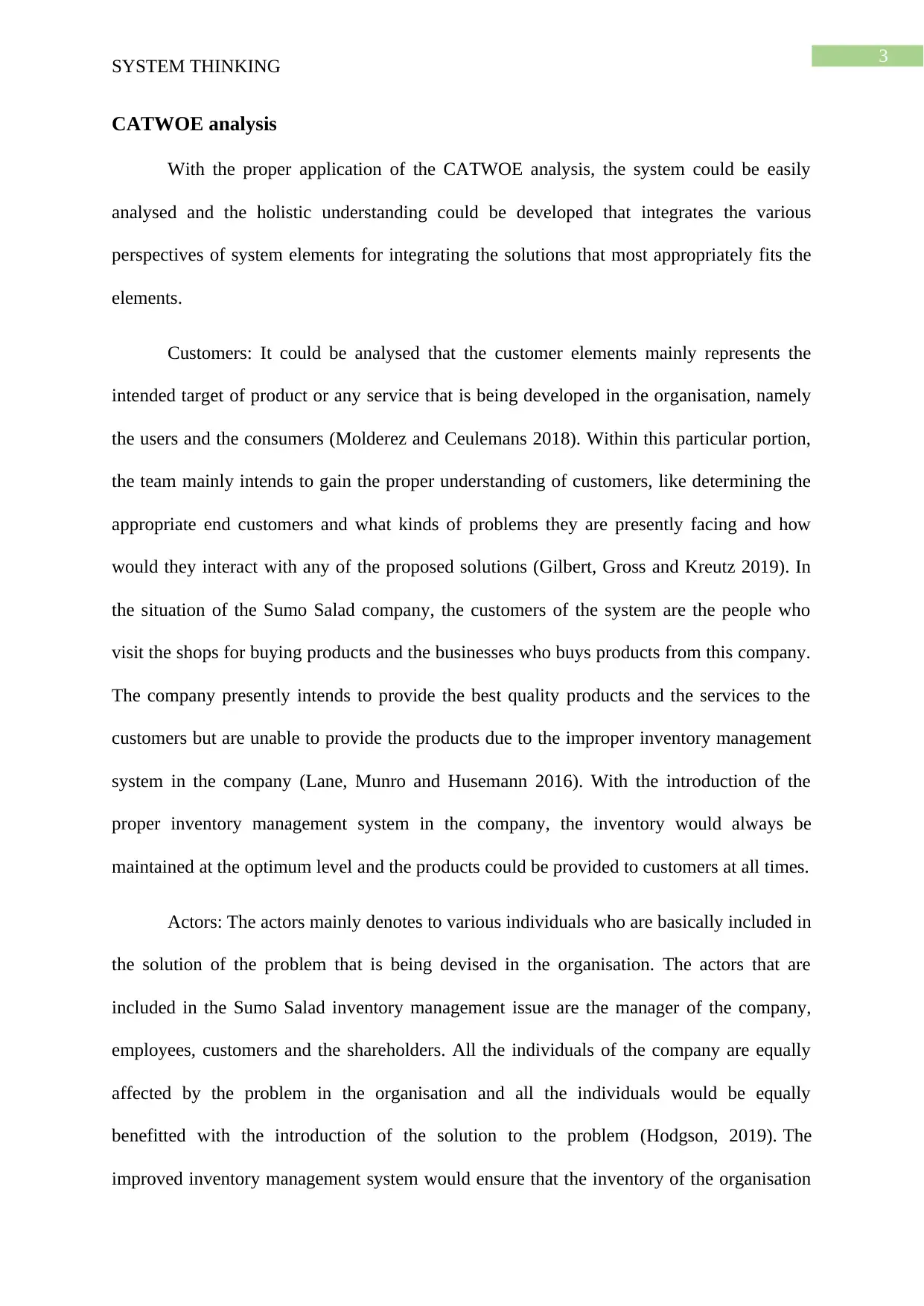
3
SYSTEM THINKING
CATWOE analysis
With the proper application of the CATWOE analysis, the system could be easily
analysed and the holistic understanding could be developed that integrates the various
perspectives of system elements for integrating the solutions that most appropriately fits the
elements.
Customers: It could be analysed that the customer elements mainly represents the
intended target of product or any service that is being developed in the organisation, namely
the users and the consumers (Molderez and Ceulemans 2018). Within this particular portion,
the team mainly intends to gain the proper understanding of customers, like determining the
appropriate end customers and what kinds of problems they are presently facing and how
would they interact with any of the proposed solutions (Gilbert, Gross and Kreutz 2019). In
the situation of the Sumo Salad company, the customers of the system are the people who
visit the shops for buying products and the businesses who buys products from this company.
The company presently intends to provide the best quality products and the services to the
customers but are unable to provide the products due to the improper inventory management
system in the company (Lane, Munro and Husemann 2016). With the introduction of the
proper inventory management system in the company, the inventory would always be
maintained at the optimum level and the products could be provided to customers at all times.
Actors: The actors mainly denotes to various individuals who are basically included in
the solution of the problem that is being devised in the organisation. The actors that are
included in the Sumo Salad inventory management issue are the manager of the company,
employees, customers and the shareholders. All the individuals of the company are equally
affected by the problem in the organisation and all the individuals would be equally
benefitted with the introduction of the solution to the problem (Hodgson, 2019). The
improved inventory management system would ensure that the inventory of the organisation
SYSTEM THINKING
CATWOE analysis
With the proper application of the CATWOE analysis, the system could be easily
analysed and the holistic understanding could be developed that integrates the various
perspectives of system elements for integrating the solutions that most appropriately fits the
elements.
Customers: It could be analysed that the customer elements mainly represents the
intended target of product or any service that is being developed in the organisation, namely
the users and the consumers (Molderez and Ceulemans 2018). Within this particular portion,
the team mainly intends to gain the proper understanding of customers, like determining the
appropriate end customers and what kinds of problems they are presently facing and how
would they interact with any of the proposed solutions (Gilbert, Gross and Kreutz 2019). In
the situation of the Sumo Salad company, the customers of the system are the people who
visit the shops for buying products and the businesses who buys products from this company.
The company presently intends to provide the best quality products and the services to the
customers but are unable to provide the products due to the improper inventory management
system in the company (Lane, Munro and Husemann 2016). With the introduction of the
proper inventory management system in the company, the inventory would always be
maintained at the optimum level and the products could be provided to customers at all times.
Actors: The actors mainly denotes to various individuals who are basically included in
the solution of the problem that is being devised in the organisation. The actors that are
included in the Sumo Salad inventory management issue are the manager of the company,
employees, customers and the shareholders. All the individuals of the company are equally
affected by the problem in the organisation and all the individuals would be equally
benefitted with the introduction of the solution to the problem (Hodgson, 2019). The
improved inventory management system would ensure that the inventory of the organisation
Paraphrase This Document
Need a fresh take? Get an instant paraphrase of this document with our AI Paraphraser
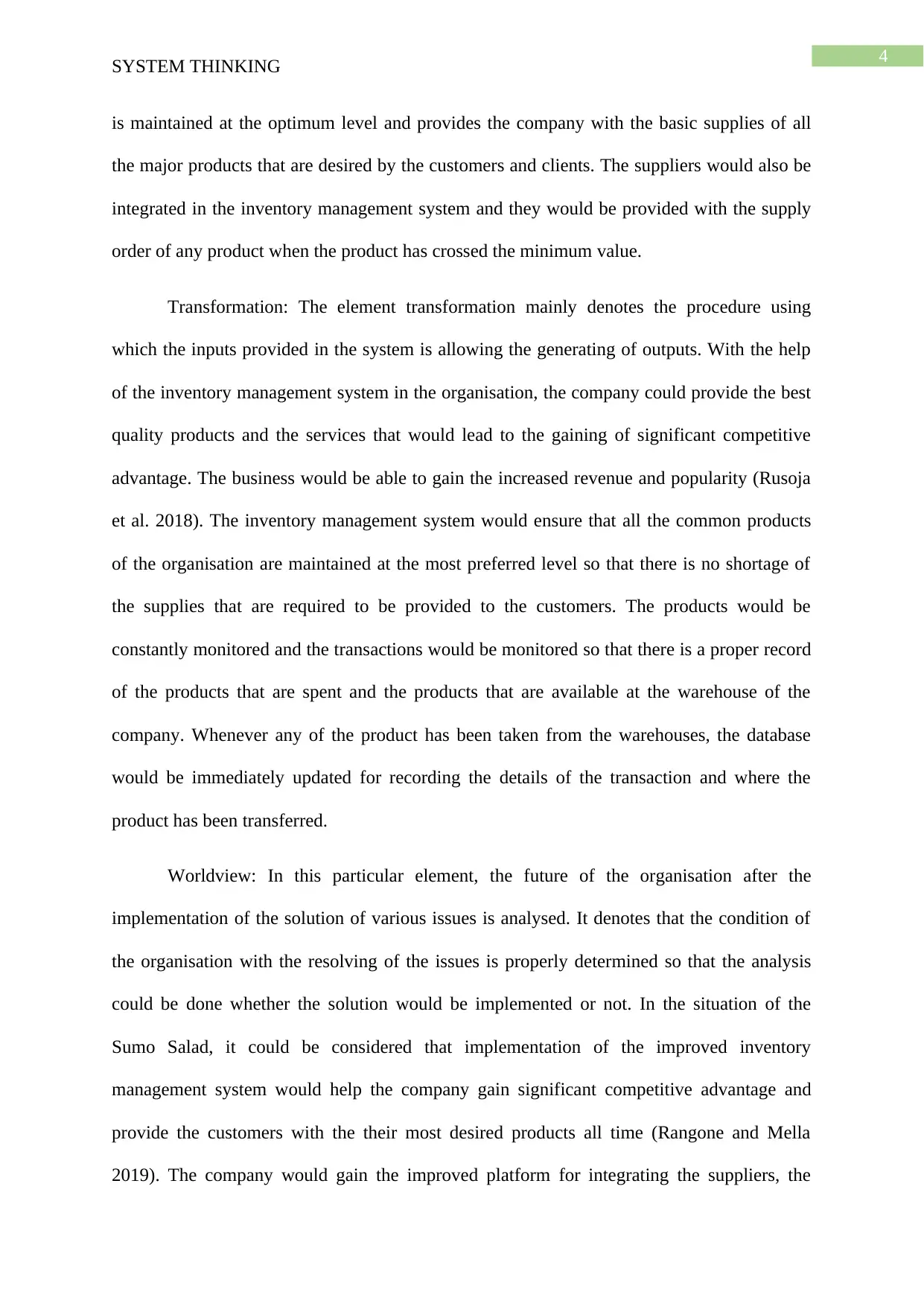
4
SYSTEM THINKING
is maintained at the optimum level and provides the company with the basic supplies of all
the major products that are desired by the customers and clients. The suppliers would also be
integrated in the inventory management system and they would be provided with the supply
order of any product when the product has crossed the minimum value.
Transformation: The element transformation mainly denotes the procedure using
which the inputs provided in the system is allowing the generating of outputs. With the help
of the inventory management system in the organisation, the company could provide the best
quality products and the services that would lead to the gaining of significant competitive
advantage. The business would be able to gain the increased revenue and popularity (Rusoja
et al. 2018). The inventory management system would ensure that all the common products
of the organisation are maintained at the most preferred level so that there is no shortage of
the supplies that are required to be provided to the customers. The products would be
constantly monitored and the transactions would be monitored so that there is a proper record
of the products that are spent and the products that are available at the warehouse of the
company. Whenever any of the product has been taken from the warehouses, the database
would be immediately updated for recording the details of the transaction and where the
product has been transferred.
Worldview: In this particular element, the future of the organisation after the
implementation of the solution of various issues is analysed. It denotes that the condition of
the organisation with the resolving of the issues is properly determined so that the analysis
could be done whether the solution would be implemented or not. In the situation of the
Sumo Salad, it could be considered that implementation of the improved inventory
management system would help the company gain significant competitive advantage and
provide the customers with the their most desired products all time (Rangone and Mella
2019). The company would gain the improved platform for integrating the suppliers, the
SYSTEM THINKING
is maintained at the optimum level and provides the company with the basic supplies of all
the major products that are desired by the customers and clients. The suppliers would also be
integrated in the inventory management system and they would be provided with the supply
order of any product when the product has crossed the minimum value.
Transformation: The element transformation mainly denotes the procedure using
which the inputs provided in the system is allowing the generating of outputs. With the help
of the inventory management system in the organisation, the company could provide the best
quality products and the services that would lead to the gaining of significant competitive
advantage. The business would be able to gain the increased revenue and popularity (Rusoja
et al. 2018). The inventory management system would ensure that all the common products
of the organisation are maintained at the most preferred level so that there is no shortage of
the supplies that are required to be provided to the customers. The products would be
constantly monitored and the transactions would be monitored so that there is a proper record
of the products that are spent and the products that are available at the warehouse of the
company. Whenever any of the product has been taken from the warehouses, the database
would be immediately updated for recording the details of the transaction and where the
product has been transferred.
Worldview: In this particular element, the future of the organisation after the
implementation of the solution of various issues is analysed. It denotes that the condition of
the organisation with the resolving of the issues is properly determined so that the analysis
could be done whether the solution would be implemented or not. In the situation of the
Sumo Salad, it could be considered that implementation of the improved inventory
management system would help the company gain significant competitive advantage and
provide the customers with the their most desired products all time (Rangone and Mella
2019). The company would gain the improved platform for integrating the suppliers, the
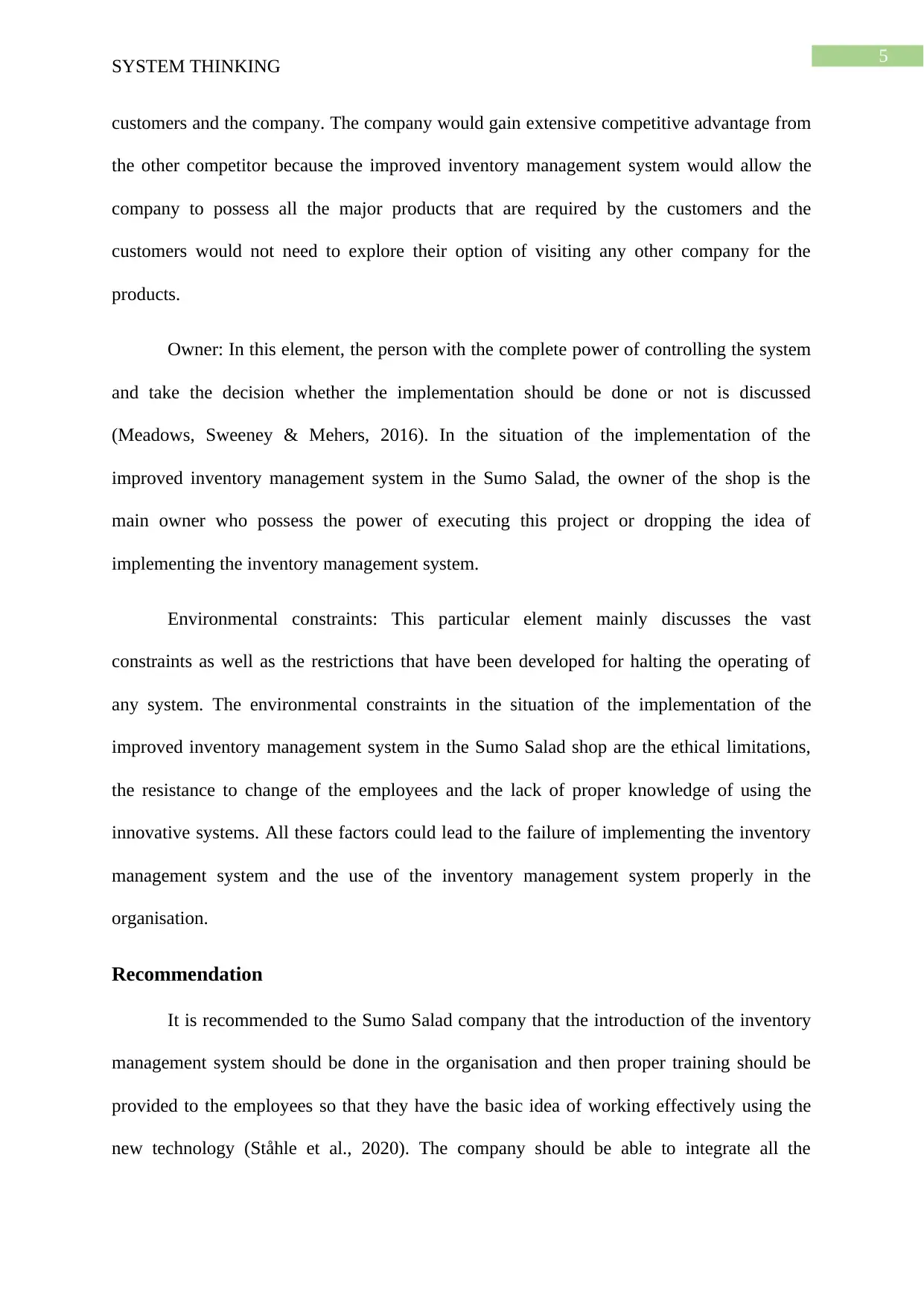
5
SYSTEM THINKING
customers and the company. The company would gain extensive competitive advantage from
the other competitor because the improved inventory management system would allow the
company to possess all the major products that are required by the customers and the
customers would not need to explore their option of visiting any other company for the
products.
Owner: In this element, the person with the complete power of controlling the system
and take the decision whether the implementation should be done or not is discussed
(Meadows, Sweeney & Mehers, 2016). In the situation of the implementation of the
improved inventory management system in the Sumo Salad, the owner of the shop is the
main owner who possess the power of executing this project or dropping the idea of
implementing the inventory management system.
Environmental constraints: This particular element mainly discusses the vast
constraints as well as the restrictions that have been developed for halting the operating of
any system. The environmental constraints in the situation of the implementation of the
improved inventory management system in the Sumo Salad shop are the ethical limitations,
the resistance to change of the employees and the lack of proper knowledge of using the
innovative systems. All these factors could lead to the failure of implementing the inventory
management system and the use of the inventory management system properly in the
organisation.
Recommendation
It is recommended to the Sumo Salad company that the introduction of the inventory
management system should be done in the organisation and then proper training should be
provided to the employees so that they have the basic idea of working effectively using the
new technology (Ståhle et al., 2020). The company should be able to integrate all the
SYSTEM THINKING
customers and the company. The company would gain extensive competitive advantage from
the other competitor because the improved inventory management system would allow the
company to possess all the major products that are required by the customers and the
customers would not need to explore their option of visiting any other company for the
products.
Owner: In this element, the person with the complete power of controlling the system
and take the decision whether the implementation should be done or not is discussed
(Meadows, Sweeney & Mehers, 2016). In the situation of the implementation of the
improved inventory management system in the Sumo Salad, the owner of the shop is the
main owner who possess the power of executing this project or dropping the idea of
implementing the inventory management system.
Environmental constraints: This particular element mainly discusses the vast
constraints as well as the restrictions that have been developed for halting the operating of
any system. The environmental constraints in the situation of the implementation of the
improved inventory management system in the Sumo Salad shop are the ethical limitations,
the resistance to change of the employees and the lack of proper knowledge of using the
innovative systems. All these factors could lead to the failure of implementing the inventory
management system and the use of the inventory management system properly in the
organisation.
Recommendation
It is recommended to the Sumo Salad company that the introduction of the inventory
management system should be done in the organisation and then proper training should be
provided to the employees so that they have the basic idea of working effectively using the
new technology (Ståhle et al., 2020). The company should be able to integrate all the
⊘ This is a preview!⊘
Do you want full access?
Subscribe today to unlock all pages.

Trusted by 1+ million students worldwide
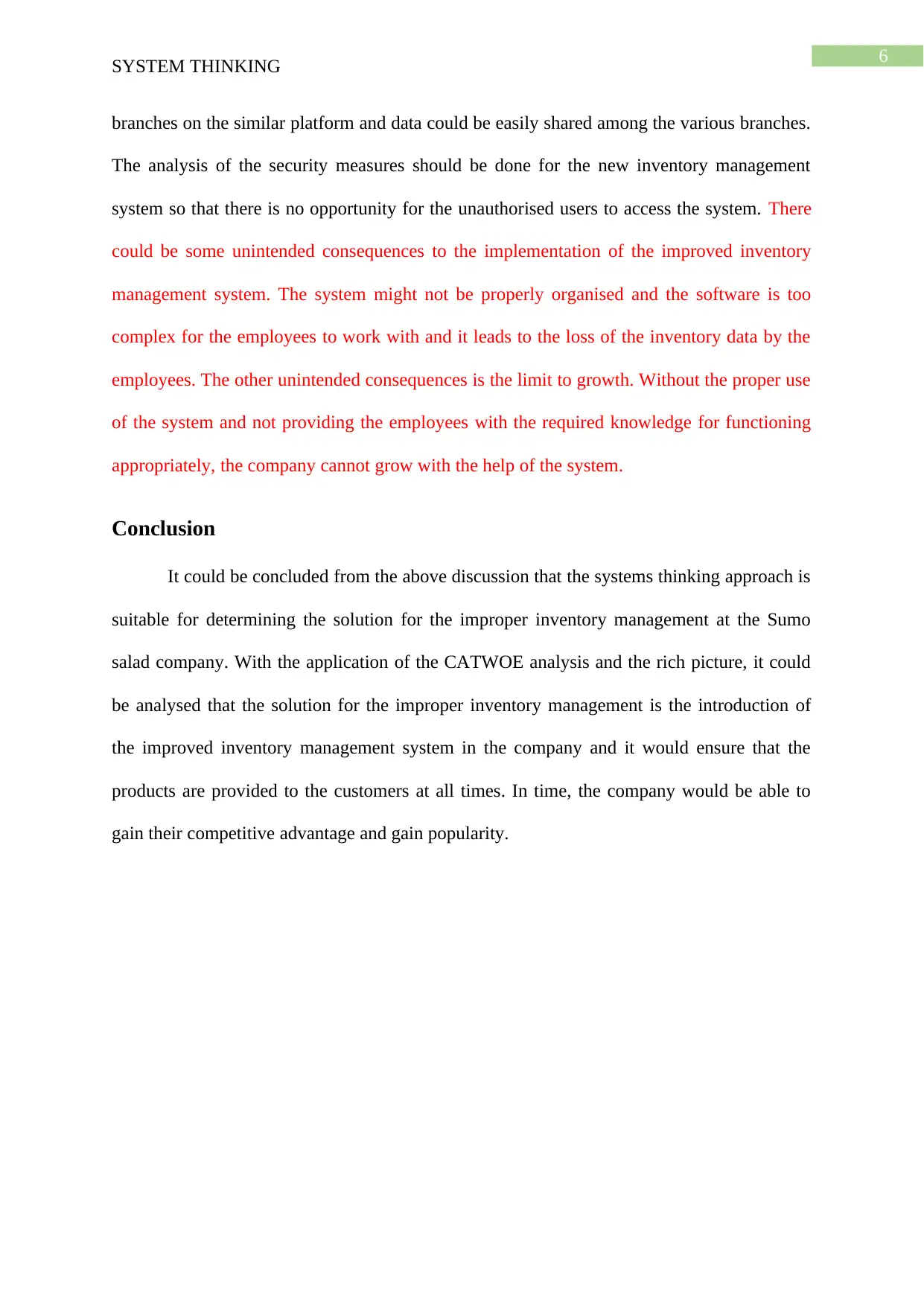
6
SYSTEM THINKING
branches on the similar platform and data could be easily shared among the various branches.
The analysis of the security measures should be done for the new inventory management
system so that there is no opportunity for the unauthorised users to access the system. There
could be some unintended consequences to the implementation of the improved inventory
management system. The system might not be properly organised and the software is too
complex for the employees to work with and it leads to the loss of the inventory data by the
employees. The other unintended consequences is the limit to growth. Without the proper use
of the system and not providing the employees with the required knowledge for functioning
appropriately, the company cannot grow with the help of the system.
Conclusion
It could be concluded from the above discussion that the systems thinking approach is
suitable for determining the solution for the improper inventory management at the Sumo
salad company. With the application of the CATWOE analysis and the rich picture, it could
be analysed that the solution for the improper inventory management is the introduction of
the improved inventory management system in the company and it would ensure that the
products are provided to the customers at all times. In time, the company would be able to
gain their competitive advantage and gain popularity.
SYSTEM THINKING
branches on the similar platform and data could be easily shared among the various branches.
The analysis of the security measures should be done for the new inventory management
system so that there is no opportunity for the unauthorised users to access the system. There
could be some unintended consequences to the implementation of the improved inventory
management system. The system might not be properly organised and the software is too
complex for the employees to work with and it leads to the loss of the inventory data by the
employees. The other unintended consequences is the limit to growth. Without the proper use
of the system and not providing the employees with the required knowledge for functioning
appropriately, the company cannot grow with the help of the system.
Conclusion
It could be concluded from the above discussion that the systems thinking approach is
suitable for determining the solution for the improper inventory management at the Sumo
salad company. With the application of the CATWOE analysis and the rich picture, it could
be analysed that the solution for the improper inventory management is the introduction of
the improved inventory management system in the company and it would ensure that the
products are provided to the customers at all times. In time, the company would be able to
gain their competitive advantage and gain popularity.
Paraphrase This Document
Need a fresh take? Get an instant paraphrase of this document with our AI Paraphraser
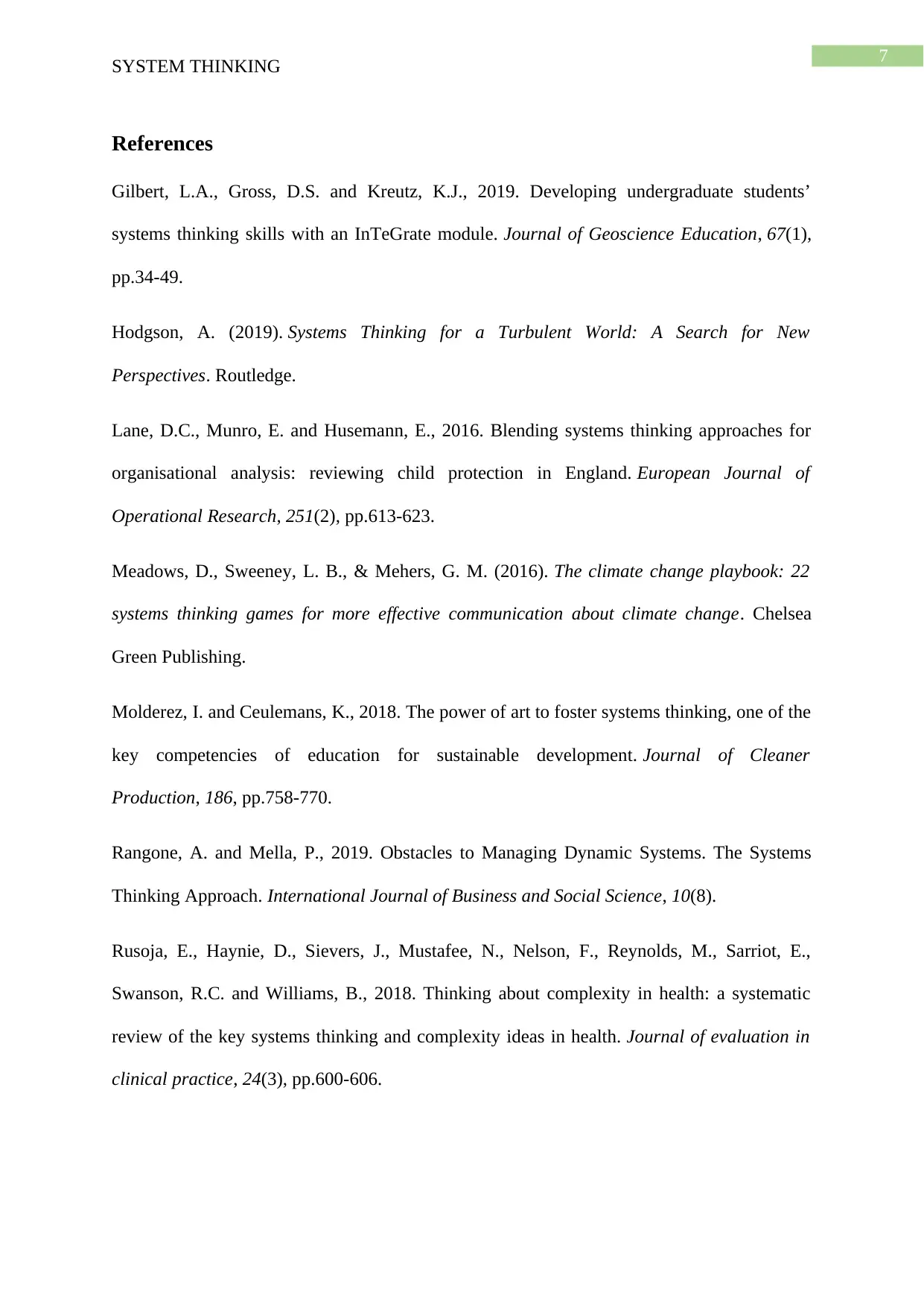
7
SYSTEM THINKING
References
Gilbert, L.A., Gross, D.S. and Kreutz, K.J., 2019. Developing undergraduate students’
systems thinking skills with an InTeGrate module. Journal of Geoscience Education, 67(1),
pp.34-49.
Hodgson, A. (2019). Systems Thinking for a Turbulent World: A Search for New
Perspectives. Routledge.
Lane, D.C., Munro, E. and Husemann, E., 2016. Blending systems thinking approaches for
organisational analysis: reviewing child protection in England. European Journal of
Operational Research, 251(2), pp.613-623.
Meadows, D., Sweeney, L. B., & Mehers, G. M. (2016). The climate change playbook: 22
systems thinking games for more effective communication about climate change. Chelsea
Green Publishing.
Molderez, I. and Ceulemans, K., 2018. The power of art to foster systems thinking, one of the
key competencies of education for sustainable development. Journal of Cleaner
Production, 186, pp.758-770.
Rangone, A. and Mella, P., 2019. Obstacles to Managing Dynamic Systems. The Systems
Thinking Approach. International Journal of Business and Social Science, 10(8).
Rusoja, E., Haynie, D., Sievers, J., Mustafee, N., Nelson, F., Reynolds, M., Sarriot, E.,
Swanson, R.C. and Williams, B., 2018. Thinking about complexity in health: a systematic
review of the key systems thinking and complexity ideas in health. Journal of evaluation in
clinical practice, 24(3), pp.600-606.
SYSTEM THINKING
References
Gilbert, L.A., Gross, D.S. and Kreutz, K.J., 2019. Developing undergraduate students’
systems thinking skills with an InTeGrate module. Journal of Geoscience Education, 67(1),
pp.34-49.
Hodgson, A. (2019). Systems Thinking for a Turbulent World: A Search for New
Perspectives. Routledge.
Lane, D.C., Munro, E. and Husemann, E., 2016. Blending systems thinking approaches for
organisational analysis: reviewing child protection in England. European Journal of
Operational Research, 251(2), pp.613-623.
Meadows, D., Sweeney, L. B., & Mehers, G. M. (2016). The climate change playbook: 22
systems thinking games for more effective communication about climate change. Chelsea
Green Publishing.
Molderez, I. and Ceulemans, K., 2018. The power of art to foster systems thinking, one of the
key competencies of education for sustainable development. Journal of Cleaner
Production, 186, pp.758-770.
Rangone, A. and Mella, P., 2019. Obstacles to Managing Dynamic Systems. The Systems
Thinking Approach. International Journal of Business and Social Science, 10(8).
Rusoja, E., Haynie, D., Sievers, J., Mustafee, N., Nelson, F., Reynolds, M., Sarriot, E.,
Swanson, R.C. and Williams, B., 2018. Thinking about complexity in health: a systematic
review of the key systems thinking and complexity ideas in health. Journal of evaluation in
clinical practice, 24(3), pp.600-606.
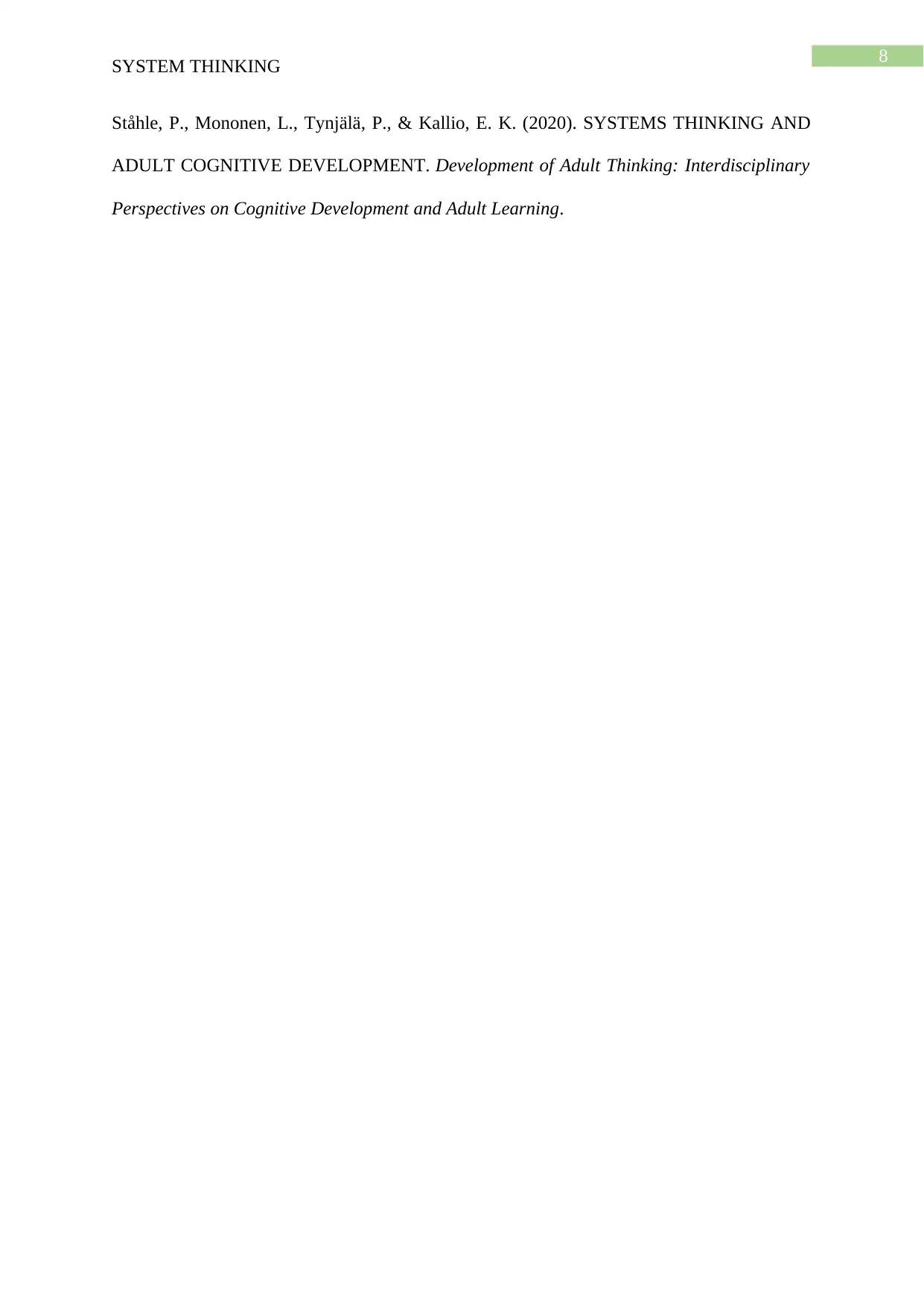
8
SYSTEM THINKING
Ståhle, P., Mononen, L., Tynjälä, P., & Kallio, E. K. (2020). SYSTEMS THINKING AND
ADULT COGNITIVE DEVELOPMENT. Development of Adult Thinking: Interdisciplinary
Perspectives on Cognitive Development and Adult Learning.
SYSTEM THINKING
Ståhle, P., Mononen, L., Tynjälä, P., & Kallio, E. K. (2020). SYSTEMS THINKING AND
ADULT COGNITIVE DEVELOPMENT. Development of Adult Thinking: Interdisciplinary
Perspectives on Cognitive Development and Adult Learning.
⊘ This is a preview!⊘
Do you want full access?
Subscribe today to unlock all pages.

Trusted by 1+ million students worldwide
1 out of 9
Related Documents
Your All-in-One AI-Powered Toolkit for Academic Success.
+13062052269
info@desklib.com
Available 24*7 on WhatsApp / Email
![[object Object]](/_next/static/media/star-bottom.7253800d.svg)
Unlock your academic potential
Copyright © 2020–2025 A2Z Services. All Rights Reserved. Developed and managed by ZUCOL.




